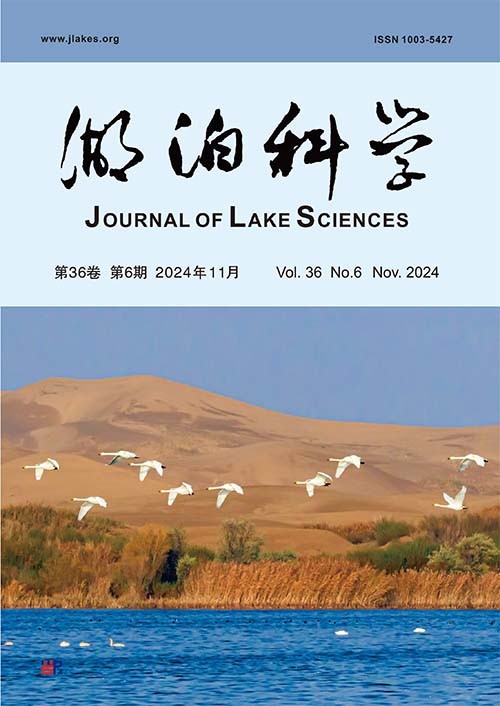Nitrogen isotopic composition of Jiulong Wetland sediments in Fanjing Mountain and Holocene climate evolution process
Q2 Earth and Planetary Sciences
引用次数: 1
Abstract
湖泊沉积物氮同位素(δ15N)在古环境、古气候变化方面有着指示气候干湿变化的重要作用,但目前学界对于δ15N记录作为气候代用指标所指示的气候干湿变化特征仍缺乏深入探索。本文以贵州省梵净山九龙池湖泊沉积物为研究对象,分析并探讨δ15N所记录的梵净山地区气候干湿变化过程与特征,并结合总有机碳(TOC)、总氮(TN)和碳氮比值(C/N)数据进行对比研究,结果表明:(1)由于九龙池湖泊沉积物有机质受流域输入影响,气候湿润时,陆生植物增多,土壤湿度增大,外源输入对湖泊沉积物有机质影响增大,沉积物δ15N值偏负;气候干旱时,陆生植物减少,土壤湿度降低,外源输入对湖泊沉积物有机质影响减小,沉积物δ15N值偏正;(2)九龙池湖泊沉积物δ15N记录很好地揭示了梵净山地区全新世的气候干湿变化过程,即早期(11.5—9.2 ka B.P.)亚洲夏季风增强,气候从干旱期向湿润期转变,中期(9.2—3.0 ka B.P.)亚洲夏季风强盛,气候整体处于湿润期,晚期(3.0—2.2 ka B.P.)亚洲夏季风减弱,气候由湿润期向干旱期方向发展。该记录与中国西南地区其他气候代用指标所记录的全新世气候变化具有区域一致性,但在部分时段有明显差异,说明西南地区气候和环境演变即响应了全球性变化又有区域特征。本研究表明,九龙池湖泊沉积物δ15N记录可用于揭示研究区域全新世气候与环境变化的特征,是一种具有实用价值的古气候代用记录。;The nitrogen isotope (δ15N) of lake sediments plays an important role in indicating climate change in terms of paleoenvironment and palaeoclimate change. However, there is still a lack of in-depth research on the characteristics of climate change indicated by δ15N records as a proxy for climate change. This paper took the sediment of Jiulong Wetland in Fanjing Mountain, Guizhou Province, as a research object, and analysed and discussed the process and characteristics of dry and wet climate change in the Fanjing Mountain area recorded by δ15N, combined with the data of total organic carbon (TOC), total nitrogen (TN) and carbon-nitrogen ratio (C/N). Finally, a comparative study was carried out, the results showed that: (1) Because the organic matter in the sediment of Jiulong Wetland was mainly from the watershed, when the climate was wet, the soil moisture increased and terrestrial plants grew well, leading to the increased external input on the organic matter to the lake and the negative δ15N value of sediment.When the climate was dry, the terrestrial plants and soil moisture decreased, leading to the reduction of the impact of external input on the organic matter in the lake sediments, the δ15N value of sediments was positive. (2) The δ15N records of the Jiulong Wetland sediments revealed well the Holocene climatic processes (dry/wet changes) in the Fanjing Mountain area. In the early (11.5-9.2 ka B.P.), the Asian summer monsoon was enhanced, and the climate evolved from dry to wet. In the middle (9.2-3.0 ka B.P.), the Asian summer monsoon was strong and the climate was in an overall wet period. In the late period (3.0-2.2 ka B.P.), the Asian summer monsoon weakened and the climate evolved from wet to dry. This record is regionally consistent with Holocene climate change recorded by other climate proxy indicators in southwest China, their differences in some periods indicating significant regional characteristics. This study shows that the sediment δ15N record of Jiulong Wetland can be used to reconstruct the characteristics of Holocene climate and environmental changes in the study area, and it is a very useful palaeoclimate proxy record.梵净山九龙湿地沉积物氮同位素组成与全新世气候演化过程
湖泊沉积物氮同位素(δ15N)在古环境、古气候变化方面有着指示气候干湿变化的重要作用,但目前学界对于δ15N记录作为气候代用指标所指示的气候干湿变化特征仍缺乏深入探索。本文以贵州省梵净山九龙池湖泊沉积物为研究对象,分析并探讨δ15N所记录的梵净山地区气候干湿变化过程与特征,并结合总有机碳(TOC)、总氮(TN)和碳氮比值(C/N)数据进行对比研究,结果表明:(1)由于九龙池湖泊沉积物有机质受流域输入影响,气候湿润时,陆生植物增多,土壤湿度增大,外源输入对湖泊沉积物有机质影响增大,沉积物δ15N值偏负;气候干旱时,陆生植物减少,土壤湿度降低,外源输入对湖泊沉积物有机质影响减小,沉积物δ15N值偏正;(2)九龙池湖泊沉积物δ15N记录很好地揭示了梵净山地区全新世的气候干湿变化过程,即早期(11.5—9.2 ka B.P.)亚洲夏季风增强,气候从干旱期向湿润期转变,中期(9.2—3.0 ka B.P.)亚洲夏季风强盛,气候整体处于湿润期,晚期(3.0—2.2 ka B.P.)亚洲夏季风减弱,气候由湿润期向干旱期方向发展。该记录与中国西南地区其他气候代用指标所记录的全新世气候变化具有区域一致性,但在部分时段有明显差异,说明西南地区气候和环境演变即响应了全球性变化又有区域特征。本研究表明,九龙池湖泊沉积物δ15N记录可用于揭示研究区域全新世气候与环境变化的特征,是一种具有实用价值的古气候代用记录。;The nitrogen isotope (δ15N) of lake sediments plays an important role in indicating climate change in terms of paleoenvironment and palaeoclimate change. However, there is still a lack of in-depth research on the characteristics of climate change indicated by δ15N records as a proxy for climate change. This paper took the sediment of Jiulong Wetland in Fanjing Mountain, Guizhou Province, as a research object, and analysed and discussed the process and characteristics of dry and wet climate change in the Fanjing Mountain area recorded by δ15N, combined with the data of total organic carbon (TOC), total nitrogen (TN) and carbon-nitrogen ratio (C/N). Finally, a comparative study was carried out, the results showed that: (1) Because the organic matter in the sediment of Jiulong Wetland was mainly from the watershed, when the climate was wet, the soil moisture increased and terrestrial plants grew well, leading to the increased external input on the organic matter to the lake and the negative δ15N value of sediment.When the climate was dry, the terrestrial plants and soil moisture decreased, leading to the reduction of the impact of external input on the organic matter in the lake sediments, the δ15N value of sediments was positive. (2) The δ15N records of the Jiulong Wetland sediments revealed well the Holocene climatic processes (dry/wet changes) in the Fanjing Mountain area. In the early (11.5-9.2 ka B.P.), the Asian summer monsoon was enhanced, and the climate evolved from dry to wet. In the middle (9.2-3.0 ka B.P.), the Asian summer monsoon was strong and the climate was in an overall wet period. In the late period (3.0-2.2 ka B.P.), the Asian summer monsoon weakened and the climate evolved from wet to dry. This record is regionally consistent with Holocene climate change recorded by other climate proxy indicators in southwest China, their differences in some periods indicating significant regional characteristics. This study shows that the sediment δ15N record of Jiulong Wetland can be used to reconstruct the characteristics of Holocene climate and environmental changes in the study area, and it is a very useful palaeoclimate proxy record.
本文章由计算机程序翻译,如有差异,请以英文原文为准。
求助全文
约1分钟内获得全文
求助全文
来源期刊

湖泊科学
Environmental Science-Water Science and Technology
CiteScore
3.70
自引率
0.00%
发文量
3253
期刊介绍:
Journal of Lake Sciences (ISSN 1003-5427) was founded in 1989 and is jointly sponsored by Nanjing Institute of Geography and Lake Sciences, Chinese Academy of Sciences and Chinese Society of Oceanology and Limnology. It mainly reports the latest research results on the changes in resources, ecology and environment of lakes (including reservoirs) and their basins under the interaction between man and nature. It publishes theoretical or applied research papers, briefs and reviews on various disciplines related to lake science (such as physics, chemistry, biology, ecology, geology, geography, etc.) as well as lake engineering and integrated basin management. Since 2006, the journal has been changed to a bimonthly publication, published on January, March, May, July, September and November 6 by Science Press.
 求助内容:
求助内容: 应助结果提醒方式:
应助结果提醒方式:


